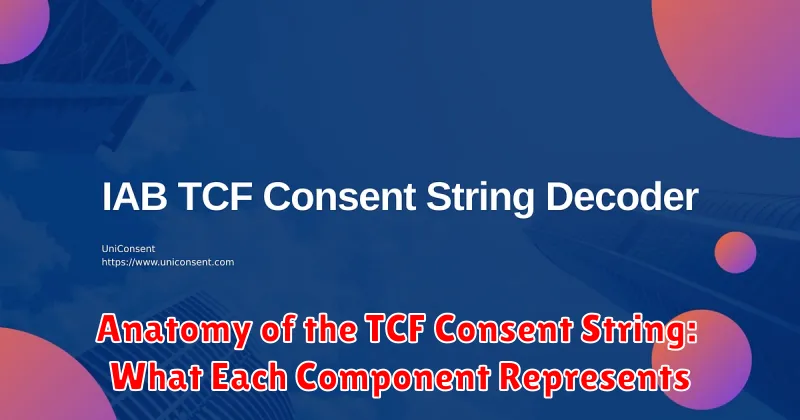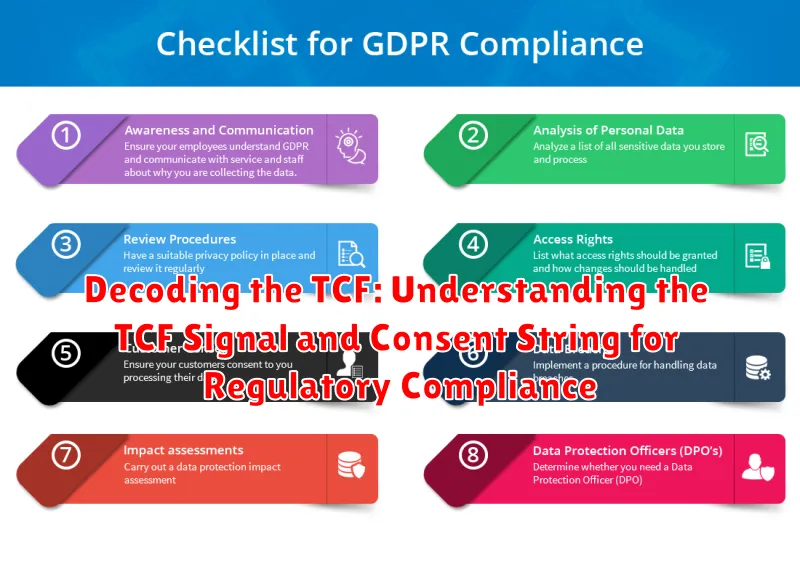In today’s data-driven landscape, navigating the complexities of regulatory compliance is paramount for businesses operating globally. One critical component of this is understanding and implementing the Transparency and Consent Framework (TCF), a standard developed by IAB Europe to help websites, publishers, and advertisers manage user consent for digital advertising. This article delves into the intricacies of the TCF, focusing specifically on the TCF signal and the structure of the consent string, providing a comprehensive guide to achieving regulatory compliance with frameworks like the GDPR and ePrivacy Directive.
This guide will decode the TCF, offering a clear and concise explanation of how it functions. We’ll explore the purpose of the TCF signal, which communicates user consent preferences across the digital advertising ecosystem. Furthermore, we’ll dissect the anatomy of the consent string, a standardized format used to encode and transmit those preferences. By understanding these key elements, businesses can effectively manage user consent, build trust, and ensure they are adhering to the necessary data privacy regulations, fostering a transparent and compliant online environment.
What is the IAB TCF (Transparency and Consent Framework)?
The IAB Transparency and Consent Framework (TCF) is an industry standard created by the Interactive Advertising Bureau (IAB) to help websites, publishers, advertisers, and technology vendors comply with data protection regulations, notably the General Data Protection Regulation (GDPR) and the ePrivacy Directive.
At its core, the TCF provides a standardized method for obtaining, managing, and transmitting user consent for the processing of personal data in the digital advertising ecosystem. It establishes a common language and technical framework that enables all parties involved in programmatic advertising to understand and respect user choices regarding data collection and usage.
The framework centers around a consent string, which encodes a user’s preferences for different vendors and purposes. This string is then shared throughout the advertising supply chain to ensure that only vendors with the appropriate consent can process data.
The Significance of the TCF Signal in the Advertising Ecosystem
The TCF (Transparency and Consent Framework) signal plays a pivotal role in ensuring responsible and compliant advertising practices within the digital ecosystem. This signal acts as a conduit, communicating user consent preferences regarding data processing for advertising purposes to all parties involved.
Without a clear and reliable TCF signal, advertisers, publishers, and ad tech vendors lack the necessary information to determine whether they have the legal basis to engage in activities such as:
- Personalized advertising
- Content personalization
- Measurement and analytics
In essence, the TCF signal fosters transparency and accountability. It empowers users by enabling them to control how their data is used, and it provides a standardized mechanism for the advertising industry to respect those choices. Failure to properly interpret and act upon the TCF signal can lead to non-compliance with privacy regulations like GDPR and ePrivacy Directive, resulting in potential legal and reputational risks.
Anatomy of the TCF Consent String: What Each Component Represents

The TCF consent string is a crucial component, encoding user consent preferences. It’s a string of characters representing various pieces of information related to consent. Understanding its structure is essential for proper TCF implementation.
Here’s a breakdown of the key components:
- Version: Indicates the TCF version used (e.g., TCF v2.0).
- Created: Timestamp of when the consent string was created.
- Last Updated: Timestamp of the last time the consent string was updated.
- CMP ID: Identifier of the Consent Management Platform (CMP) that generated the string.
- CMP Version: Version of the CMP used.
- Consent Given: A series of bits representing whether the user has given consent for each vendor and purpose.
- Vendor Consent: Specific consent choices for each vendor registered within the TCF framework.
- Purpose Consent: Indicates consent for different processing purposes defined by the TCF.
- Special Feature Opt-ins: Indicates opt-ins for special features.
Each section contributes to a comprehensive record of user consent, enabling transparent and compliant data processing within the digital advertising ecosystem. Properly parsing and interpreting this string is critical for respecting user choices and adhering to privacy regulations.
How the TCF Facilitates GDPR and ePrivacy Compliance
The IAB TCF (Transparency and Consent Framework) plays a vital role in helping websites, publishers, and advertisers comply with the General Data Protection Regulation (GDPR) and the ePrivacy Directive, particularly the ePrivacy Regulation (once finalized). These regulations mandate that users must provide explicit consent before their personal data can be collected and processed.
The TCF establishes a standardized mechanism for obtaining and managing user consent for various purposes, such as:
- Serving personalized advertisements
- Measuring ad performance
- Conducting market research
By implementing the TCF, organizations can demonstrate a commitment to user privacy and data protection, as they are adhering to a recognized industry standard for consent management. The TCF Consent String acts as a record of user consent, which can be shared across the advertising ecosystem to ensure that user preferences are respected. This centralized approach simplifies the compliance process and reduces the risk of non-compliance with GDPR and ePrivacy regulations.
The Role of Consent Management Platforms (CMPs) in TCF Implementation
Consent Management Platforms (CMPs) are pivotal in TCF implementation. They act as the intermediary between publishers, advertisers, and users, managing user consent in accordance with the TCF framework.
CMPs perform several critical functions:
- Collecting Consent: They obtain explicit consent from users regarding data processing purposes and vendors.
- Storing Consent: They securely store the user’s consent choices, ensuring accurate record-keeping.
- Creating and Distributing the Consent String: They generate the TCF consent string and distribute it to ad tech vendors, enabling them to honor user preferences.
- Updating Consent: They provide mechanisms for users to easily update or withdraw their consent.
By automating these processes, CMPs significantly simplify the complexities of GDPR and ePrivacy Directive compliance for websites and applications within the digital advertising ecosystem. Choosing a certified CMP is crucial for ensuring accurate and compliant TCF implementation.
Understanding Vendor Stacks and Consent Preferences within the TCF
The Transparency and Consent Framework (TCF) revolves around the concept of vendor stacks. A vendor stack represents the specific set of advertising technology vendors operating on a website or app. Each vendor within the stack has specific purposes for processing user data.
Within the TCF, users are given the ability to express their consent preferences for each vendor and each purpose. This granular control allows users to decide which vendors can process their data and for what specific reasons. Consent Management Platforms (CMPs) play a vital role in collecting and managing these user preferences.
The consent string encapsulates all of these choices. It contains data indicating which vendors have consent for which purposes, respecting the individual user’s decisions.
Best Practices for Implementing the TCF on Your Website or App
Implementing the Transparency and Consent Framework (TCF) effectively requires careful planning and execution. The following best practices are designed to help ensure compliance and maintain user trust.
1. Choose a Certified CMP: Select a Consent Management Platform (CMP) that is officially certified by the IAB Europe. This ensures the CMP adheres to the latest TCF specifications and provides accurate consent signals.
2. Integrate the CMP Correctly: Ensure the CMP is properly integrated into your website or app. This includes placing the CMP script in the correct location and configuring it to handle user consent preferences appropriately.
3. Customize Your Consent Notice: Tailor your consent notice to clearly explain the purposes for which data is being processed and the vendors involved. Use plain language that is easy for users to understand.
4. Regularly Update Your Vendor List: Maintain an up-to-date vendor list within your CMP. This ensures that users are informed about all third parties that may be processing their data.
5. Test Thoroughly: Before deploying the TCF implementation to a live environment, conduct thorough testing to verify that consent signals are being generated and transmitted correctly.
Troubleshooting Common Issues with TCF Signals and Consent Strings

Implementing the Transparency and Consent Framework (TCF) can present technical challenges. Common issues often stem from incorrect implementation or misinterpretation of the TCF signal and consent string.
Common Problems and Solutions
- Invalid Consent String: This typically occurs due to malformed strings or corrupted data. Ensure your Consent Management Platform (CMP) is correctly configured and transmitting valid strings. Verify the string against IAB specifications.
- TCF Signal Not Detected: If vendors are not receiving the TCF signal, check your CMP integration. Confirm the CMP is properly installed and activated on all relevant pages/screens. Also, investigate potential conflicts with other scripts.
- Incorrect Consent Interpretation: Vendors may misinterpret consent preferences if the TCF signal is incorrectly parsed. Review vendor documentation and ensure they are using an IAB-certified CMP.
- CMP Conflicts: Multiple CMPs can lead to conflicts and data inconsistencies. Implement a single CMP and ensure it handles all consent requests.
When troubleshooting, utilize browser developer tools to inspect network requests and console logs for errors. Contact your CMP provider for specific support and guidance.
The Future of the TCF and its Impact on Digital Advertising
The Transparency and Consent Framework (TCF) is continuously evolving to adapt to the dynamic landscape of digital advertising and increasing privacy concerns. Its future likely involves enhancements to address emerging challenges and solidify its role as a cornerstone of regulatory compliance.
Several key trends are anticipated:
- Increased Scrutiny from Regulatory Bodies: Expect continued audits and potential refinements based on feedback from data protection authorities.
- Technological Advancements: Adaptation to new advertising technologies and evolving user expectations regarding privacy.
- Enhanced User Control: Greater emphasis on providing users with more granular control over their consent preferences.
- Broader Industry Adoption: Further expansion of the TCF beyond Europe, potentially influencing global privacy standards.
The TCF’s impact on digital advertising will likely be significant. Businesses that embrace and effectively implement the TCF are better positioned to navigate the complex regulatory environment, maintain user trust, and ensure sustainable advertising practices. Failure to adapt could lead to regulatory penalties and erosion of consumer confidence.

